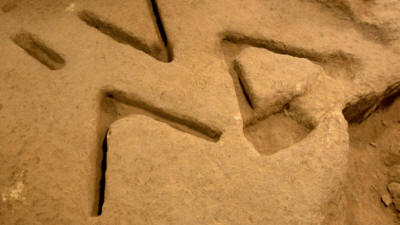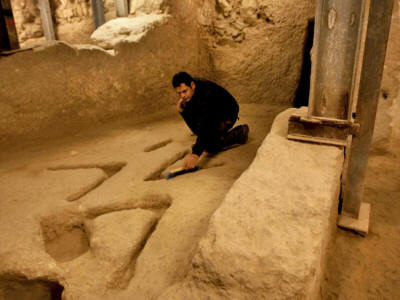|
December 7, 2011 from CBSNews Website
Marks carved in the bedrock over 2,800 years ago, are seen in an archeological excavation in the city of David near Jerusalem's Old City.
(Associated Press)
(AP) JERUSALEM
Mysterious stone carvings made thousands
of years ago and recently uncovered in an excavation underneath
Jerusalem have archaeologists stumped.
There were no finds to offer any clues
pointing to the identity of who made them or what purpose they
served.
The shapes were found in a dig known as the City of David, a politically sensitive excavation conducted by Israeli government archaeologists and funded by a nationalist Jewish group under the Palestinian neighborhood of Silwan in east Jerusalem.
The rooms were unearthed as part of the
excavation of fortifications around the ancient city's only natural
water source, the Gihon spring. Israel's Antiquities Authority archeologist Eli Shukron sweeps marks carved in the bedrock in an archeological excavation in the city of David near Jerusalem's Old City. The mysterious stone carvings made thousands of years ago and recently uncovered
in an excavation
underneath Jerusalem have archaeologists stumped. It is possible, the dig's archaeologists say, that when the markings were made at least 2,800 years ago the shapes might have accommodated some kind of wooden structure that stood inside them, or they might have served some other purpose on their own.
They might have had a ritual function or one that was entirely mundane.
Archaeologists faced by a curious
artifact can usually at least venture a guess about its nature, but
in this case no one, including outside experts consulted by Shukron
and the dig's co-director, archaeologists with decades of experience
between them, has any idea.
A century-old map of an expedition led by the British explorer Montague Parker, who searched for the lost treasures of the Jewish Temple in Jerusalem between 1909 and 1911, includes the shape of a "V'' drawn in an underground channel not far away.
Modern archaeologists haven't excavated
that area yet.
Such stones were used in the ancient
Middle East as a focal point for ritual or a memorial for dead
ancestors, the archaeologists say, and it is likely a remnant of the
pagan religions which the city's Israelite prophets tried to
eradicate. It is the first such stone to be found intact in
Jerusalem excavations.
The results ranged from the thought-provoking,
The City of David dig, where the carvings were found, is the most high-profile and politically contentious excavation in the Holy Land.
Named for the biblical monarch thought
to have ruled from the spot 3,000 years ago, the dig is located in
what today is east Jerusalem, which was captured by Israel in 1967.
Palestinians claim that part of the city as the capital of a future
state.
The group also moves Jewish families into the neighborhood and elsewhere in east Jerusalem in an attempt to render impossible any division of the city in a future peace deal. Palestinians and some Israeli archaeologists have criticized the dig for what they say is an excessive focus on Jewish remains.
The dig's archaeologists, who work under the auspices of the government's Israel Antiquities Authority, deny that charge.
|



